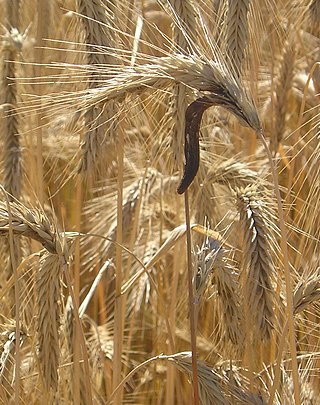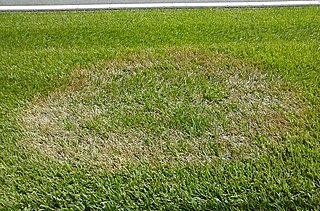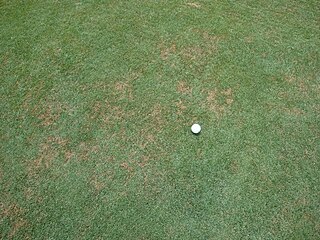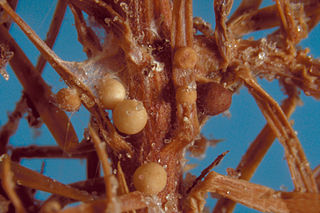
Fusarium patch is a disease in turf grass settings also called pink snow mold or Microdochium patch. In many cool season grass species in North America, it is caused by the fungus Microdochium nivale. The white-pink mycelium on infected leaf blades is a distinguishing characteristic of the Microdochium nivale pathogen. Fusarium patch is considered economically important in the turf grass industry because of its tendency to cause significant injury to golf greens, thereby decreasing putting surface quality. Dissimilar from other snow molds, such as gray snow mold, Microdochium nivale does not need snow cover to cause widespread infection.

A sclerotium, is a compact mass of hardened fungal mycelium containing food reserves. One role of sclerotia is to survive environmental extremes. In some higher fungi such as ergot, sclerotia become detached and remain dormant until favorable growth conditions return. Sclerotia initially were mistaken for individual organisms and described as separate species until Louis René Tulasne proved in 1853 that sclerotia are only a stage in the life cycle of some fungi. Further investigation showed that this stage appears in many fungi belonging to many diverse groups. Sclerotia are important in the understanding of the life cycle and reproduction of fungi, as a food source, as medicine, and in agricultural blight management.
Sclerotinia borealis or snow scald is a psychrophilic necrotrophic plant pathogen with wide host range, including crop plants, such as barley, rye and wheat, and thus causing much economical damage.
Pythium volutum is a plant pathogen infecting wheat, barley, and turfgrass. It is known to be sensitive to some of the compounds typically present in selective media commonly used for isolating Pythium spp., so isolation may require alternative methods.

Sclerotinia sclerotiorum is a plant pathogenic fungus and can cause a disease called white mold if conditions are conducive. S. sclerotiorum can also be known as cottony rot, watery soft rot, stem rot, drop, crown rot and blossom blight. A key characteristic of this pathogen is its ability to produce black resting structures known as sclerotia and white fuzzy growths of mycelium on the plant it infects. These sclerotia give rise to a fruiting body in the spring that produces spores in a sac which is why fungi in this class are called sac fungi (Ascomycota). This pathogen can occur on many continents and has a wide host range of plants. When S. sclerotiorum is onset in the field by favorable environmental conditions, losses can be great and control measures should be considered.
Typhula ishikariensis is, along with Typhula incarnata, the causal agent of grey snow mould, an obligately parasitic plant pathogen that can destroy turfgrass when covered for a long period with snow. It is a particular problem on golf courses established in unsuitable areas. More importantly, it can also damage crops of winter wheat. The species was described as new to science in 1930 by Japanese mycologist Sanshi Imai. The varieties canadensis and ishikariensis were described in 1978. There is a wide variety within the species and not all authorities agree as to subspecies, or even whether it should be monophyletic.
Colletotrichum cereale is a plant disease (fungus) that has been found to cause crown rot anthracnose of turf grass most commonly occurring on golf courses. Anthracnose can occur as both a foliar blight and basal rot. This disease attacks the crowns of plants, which is different than other anthracnose diseases. Anthracnose of turfgrass can be a foliar disease or in this case a basal rot of the lower portion of the plant. It attacks different species of turfgrass throughout the world most commonly annual bluegrass and creeping bentgrass.

Brown patch is a common turfgrass fungal disease that is caused by species in the genus Rhizoctonia, usually Rhizoctonia solani. Brown patch can be found in all of the cool season turfgrasses found in the United States. Brown patch is most devastating to: Bentgrass, ryegrass, Annual bluegrass, and Tall fescue. Brown patch is also found in Kentucky bluegrass and Fine fescue but this is rare or does minimal damage. Brown patch is known as a foliar disease, so it does not have any effect on the crown or roots of the turf plant.
Pythiumdisease, also known as "Pythiumblight," "cottony blight," or "grease spot," is a highly destructive turfgrass disease caused by several different Pythium species. All naturally cultivated cool-season turfgrasses are susceptible to Pythium and if conditions are favorable to Pythium it can destroy a whole turfgrass stand in a few days or less. Pythium favors hot and very humid weather and will usually develop in low areas or swales in the turfgrass.
Red thread disease is a fungal infection found on lawns and other turfed areas. It is caused by the corticioid fungus Laetisaria fuciformis and has two separate stages. The stage that gives the infection its name is characterised by very thin, red, needle-like strands extending from the grass blade. These are stromata, which can remain viable in soil for two years. After germinating, the stromata infect grass leaf blades through their stomata. The other stage is visible as small, pink, cotton wool-like mycelium, found where the blades meet. It is common when both warmth and humidity are high.

Typhula is a genus of clavarioid fungi in the order Agaricales. Species of Typhula are saprotrophic, mostly decomposing leaves, twigs, and herbaceous material. Basidiocarps are club-shaped or narrowly cylindrical and are simple, often arising from sclerotia. A few species are facultative plant pathogens, causing a number of commercially important crop and turfgrass diseases.
Dollar spot is a fungal disease of turfgrass caused by the four species in the genus Clarireedia, in the family Rutstroemiaceae. The pathogen blights leaf tissues but does not affect turf grass roots or crowns. There is evidence that a fungal mycotoxin produced by the pathogen may cause root damage, including necrosis of the apical meristem in creeping bentgrass. However, the importance of this toxin is unknown and its effects are not considered a direct symptom of dollar spot. The disease is a common concern on golf courses on intensely managed putting greens, fairways and bowling greens. It is also common on less rigorously maintained lawns and recreational fields. Disease symptoms commonly result in poor turf quality and appearance. The disease occurs from late spring through late fall, but is most active under conditions of high humidity and warm daytime temperatures 59–86 °F (15–30 °C) and cool nights in the spring, early summer and fall. The disease infects by producing a mycelium, which can be spread mechanically from one area to another.
Typhula blight is most commonly known as a turf disease, but can also be a problem with wheat. Typhula blight is caused by a Typhula fungus, either Typhula incarnata or T. ishikariensis. Typhula incarnata is the causal agent for gray snow mold and T. ishikariensis causes speckled snow mold. Snow molds are caused by cold tolerant fungi that require snow cover or prolonged periods of cold, wet conditions. Typhula blight is most notably found in the turf industry, affecting a wide range of turfgrasses. Upon the snow melt, gray circular patches of mycelium are found. These mycelia produce a survival structure called a sclerotia that survives the warm summer months. Typhula blight is commonly controlled with fungicide applications in the late fall and by other cultural practices. If unchecked, snow molds can cause severe turf loss.
Snow mold is a type of fungus and a turf disease that damages or kills grass after snow melts, typically in late winter. Its damage is usually concentrated in circles three to twelve inches in diameter, although yards may have many of these circles, sometimes to the point at which it becomes hard to differentiate between different circles. Snow mold comes in two varieties: pink or gray. While it can affect all types of grasses, Kentucky bluegrass and fescue lawns are least affected by snow mold.

Turf melting out is caused by the fungal pathogen Dreschlera poae, in the family Pleosporaceae. It is a common problem on turfgrass and affects many different species. The disease infects all parts of the plant most commonly on golf course roughs, sports fields, and home lawns. There are two stages of the disease: the leaf blade infection and the crown and root infection Melting out occurs during the cool weather of April and May and is encouraged by high nitrogen fertility. The disease is spread by wind-blown or water splashed spores and survive in thatch.

Phomopsisblight of juniper is a foliar disease discovered in 1917 caused by the fungal pathogen Phomopsis juniperovora. The fungus infects new growth of juniper trees or shrubs, i.e. the seedlings or young shoots of mature trees. Infection begins with the germination of asexual conidia, borne from pycnidia, on susceptible tissue, the mycelia gradually move inwards down the branch, and into the main stem. Management strategies mainly include removing and destroying diseased tissue and limiting the presence of moisture on plants. Junipers become resistant to infection as they mature and the young yellow shoots turn dark green. Preventive strategies include planting only resistant varieties and spraying new growth with fungicide until plants have matured.
Necrotic ring spot is a common disease of turf caused by soil borne fungi that mainly infects roots (4). It is an important disease as it destroys the appearance of turfgrasses on park, playing fields and golf courses. Necrotic Ring Spot is caused by a fungal pathogen that is an ascomycete that produces ascospores in an ascocarp (6). They survive over winter, or any unfavorable condition as sclerotia. Most infection occurs in spring and fall when the temperature is about 13 to 28 °C (5). The primary hosts of this disease are cool-season grasses such as Kentucky bluegrass and annual bluegrass (6). Once turf is infected with O. korrae, it kills turf roots and crowns. Symptoms of the disease are quite noticeable since they appear as large yellow ring-shaped patches of dead turf. Management of the disease is often uneasy and requires application of multiple controls. The disease can be controlled by many different kind of controls including chemicals and cultural.
Gray leaf spot (GLS) is a foliar fungal disease that affects grasses. In grasses other than maize it is caused by Pyricularia grisea, which only infects perennial ryegrass, tall fescue, and St. Augustine grass in places with warm and rainy climates.

Botrytis elliptica is a necrotrophic fungal pathogen which infects species of plants in the Lilium genus, causing the disease commonly known as Lily Gray Mold. The symptoms of Lily Gray Mold include the appearance of water-soaked spots on leaves which appear white and increase in darkness with age, ranging from gray to brown. These spots may cover the entire leaf, complemented with a gray webbing, containing the fungal spores. The leaves will appear wilted and branches may die back. In addition to leaves, petals, stems, and buds may be infected, and this gray webbing will eventually cover the plant, feigning the appearance of gray flowers. Infected buds often rot. Lily Gray Mold disease, if not properly treated, will appear each year with increasing vigor.

Agroathelia rolfsii is a corticioid fungus in the order Amylocorticiales. It is a facultative plant pathogen and is the causal agent of "southern blight" disease in crops.









